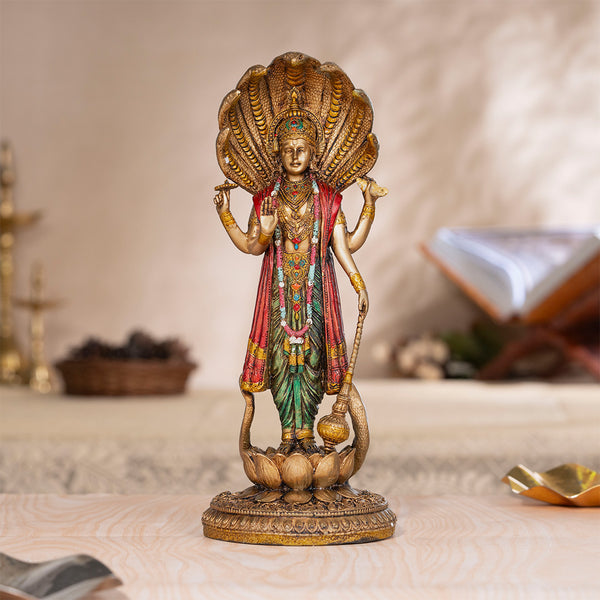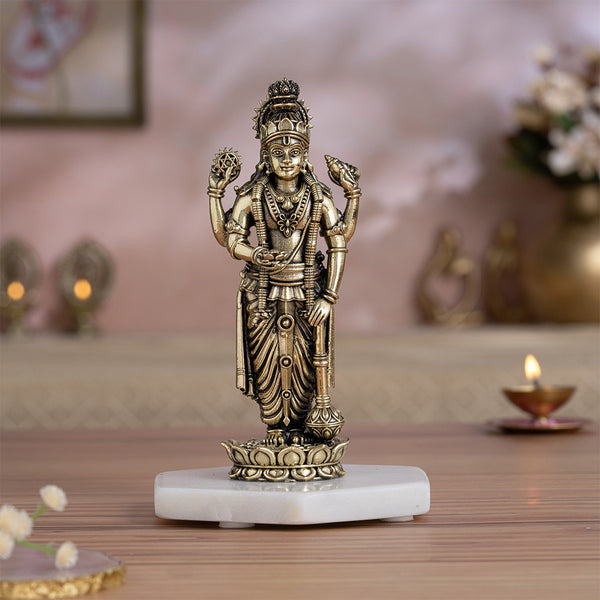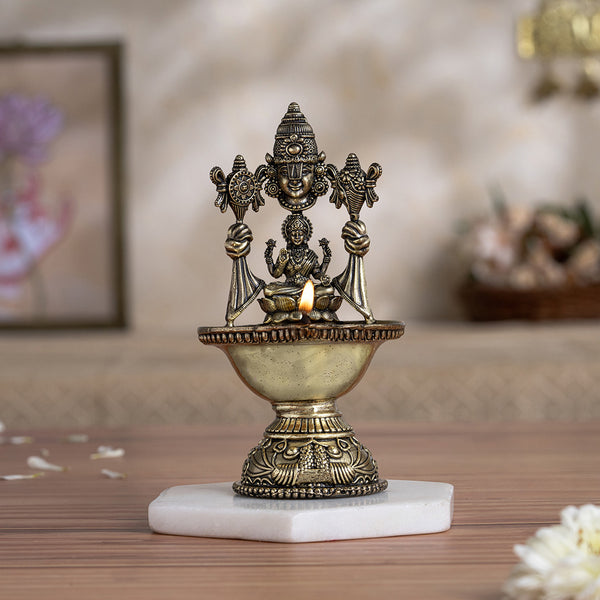In Hinduism, Vishnu is one of the main three gods along with Brahma the creator, and Shiva the destroyer. Vishnu is often seen as the most benevolent. His divine form is depicted in intricately carved idols known as Lord Vishnu idols.
Lord Vishnu is believed to have taken on ten different forms, which are called the Ten Avatars of Lord Vishnu or the Dashavatara. Lord Vishnu is believed to incarnate as one of his avatars when the world is in chaos.
All of Vishnu's Avatars share the same goal, achieved through different incarnations, each with its own legend. The divine mission was to restore Dharma and righteousness, protecting the world and virtuous beings from evil, demons, and Asuras.
The Matsya avatar is one of Hinduism's most ancient incarnations of Lord Vishnu, the god known as the Preserver. Mythology states that Vishnu took the form of a fish to save humanity and sacred texts from a catastrophic flood.

Lord Vishnu Standing Antique Idol (12 Inch)

Brass Standing Lord Vishnu Murti (6 Inch)
In this article, we will look at the story behind the Matsya Avatar of Vishnu.
Life Before Matsya Avatar Of Vishnu

Long ago, during a time when people had become selfish and immoral, the gods decided to bring order back to the world by making the whole world drown in a flood.
Lord Brahma, responsible for recreating the world, worked tirelessly according to the wisdom found in the Vedas, the source of knowledge.
However, during his exhausting task, Lord Brahma fell asleep and a demon named Hayagriva, with a horse's head, was born from his nose. Hayagriva cunningly stole the Vedas from Lord Brahma and escaped.
Thankfully, Lord Vishnu noticed the theft and descended to Earth in the form of a small fish known as the Matsya avatar, the first avatar of Vishnu. Why did Vishnu take the Matsya avatar?
To retrieve the stolen Vedas and restore balance to the world. He appeared before the great King Vaivasvat Manu, seeking his help and guidance to retrieve the stolen Vedas.
Story Of Matsya Avatar Of Vishnu

1. Encounter With King Manu
King Manu, a deeply devoted and righteous ruler, was engaged in his spiritual practices near the ocean. As he took some water in his hands, he noticed a tiny fish swimming in them.
The fish pleaded with the king to save its life, fearing that it would be devoured by larger creatures. Touched by compassion, the king placed the fish in a small tank within his palace.
To his amazement, the fish began to grow rapidly, outgrowing the tank in no time. The king then moved it to a small pond, but the fish continued to grow until even the pond couldn't contain it.
Realizing its extraordinary size, King Manu decided to release the fish into a river, and eventually back into the vast ocean.
To his astonishment, the fish revealed itself as Lord Vishnu, the supreme deity, who had taken the form of the fish to test King Manu's faith and virtue.
As King Manu humbly bowed before the divine Matsya, Lord Vishnu disclosed the forthcoming flood and shared his divine wisdom with the king.
2. Preparing And Surviving The Greatest Flood
Lord Matsya, the divine fish, advised King Manu to gather representatives from every species of plants and animals, along with the seven great sages, and bring them aboard an ark to save them from the impending destruction caused by the flood.
On the seventh day, when the heavy rains and storms arrived, Lord Matsya appeared before the king and instructed him to secure the ark to his horn using the serpent Vasuki as a rope. Lord Matsya shielded the ark from destruction during the cataclysmic flood.
While safeguarding the ark and guiding it towards Mount Hemavan, Lord Matsya also defeated the demon Hayagriva and returned the stolen Vedas to Lord Brahma.
During the journey, Lord Matsya shared profound wisdom and revealed important truths to the king.
Upon reaching Mount Hemavan, Lord Matsya vanished from the earth after instructing King Manu on how to rebuild and govern the new world with a fresh set of rules and moral values.
This valuable knowledge became known as Manusmriti - the memories of Manu.
Symbolism And Significance Of Matsya Avatar Of Vishnu

The story of Lord Vishnu's Matsya Avatar holds a symbolic meaning, which can be understood as a parable. One interpretation suggests that the fish represents the beginning of aquatic life, highlighting the evolutionary process.
In Hindu mythology, such stories are often used to convey deeper messages. Another interpretation draws a comparison to Sri Aurobindo's concept of Kundalini awakening.
The small fish symbolizes the initial descent of Kundalini energy, which gradually grows and surpasses every place it resides. This awakened knowledge, represented by the fish, becomes instrumental in saving humanity.
The flood in the story symbolizes Maya, the illusion of worldly desires that poses a threat to our inner peace.
The boat represents our consciousness, which can only be saved through the awakening of knowledge (the fish) from the destructive waves of Maya.
The seven great sages symbolize the seven chakras, the centers of knowledge within our bodies. Taking the boat to Mount Hemavan signifies seeking refuge from worldly desires, enabling us to rise above them and attain truth and peace.
Mount Hemavan represents our highest center of knowledge, located in our head.

Brass Narayana/Vishnu Lakshmi on Ananta-Sajya (5.5 Inch)

Brass Tirupati Balaji Lakshmi Divine Diya (5.5 Inch)
Conclusion
The story of Vishnu's First Avatar as a fish is full of deep meanings and lessons. It shows how life evolved over time and also works as a metaphor to explain greater philosophical ideas.
If you look at the Matsya Avatar story through the lens of Kundalini waking, the small fish represents the first drop of energy that grows in strength and importance as it awakens. It shows how information can change things and how it can help save people.







